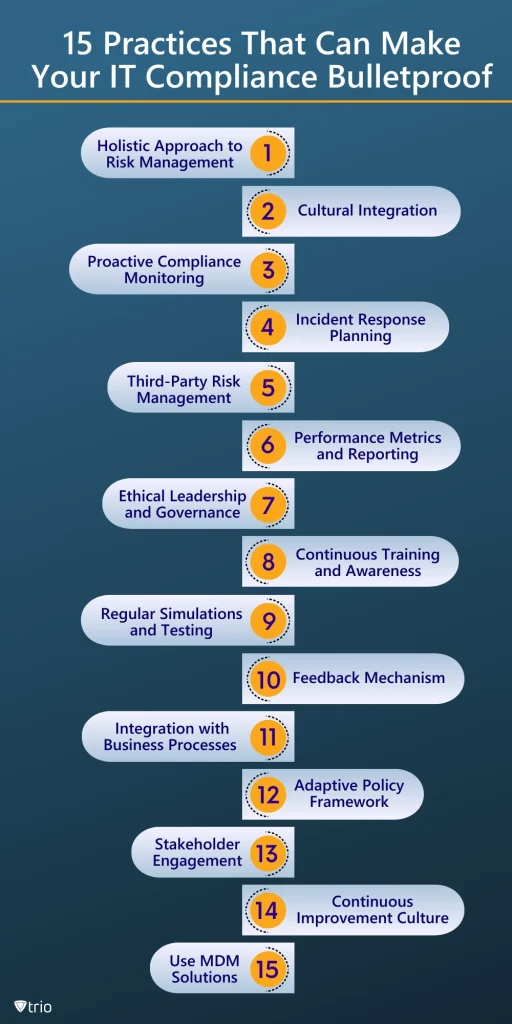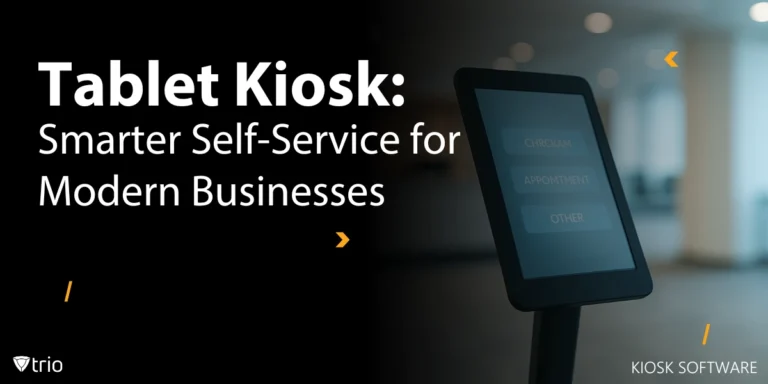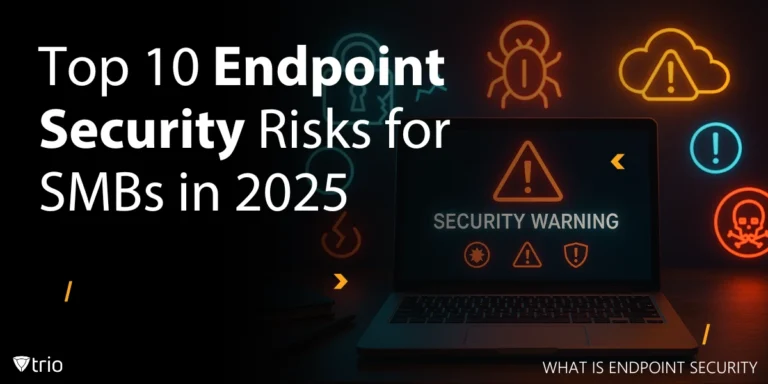$14.8 million—that’s the average price tag of a single non-compliance event, more than 2× the cost of simply staying compliant. For small and midsize businesses (SMBs), even one six-figure penalty or breach can wipe out an entire year’s IT budget.
If you’re an IT admin at an SMB, you probably feel this pain every day:
- Juggling HIPAA, GDPR, PCI-DSS, and vendor audits with a team of one or two.
- Trying to lock down employee laptops and phones without the enterprise-grade headcount (or spend).
- Fighting legacy “Franken-tools” that make every audit a ticket-chasing nightmare.
This guide will show you how to:
- Build an iron-clad digital compliance policy from the ground up.
- Apply 15 advanced best practices—each mapped to mobile-device-management (MDM) you can automate.
- Give you an idea of how much doing nothing costs.
- See where Trio, a lean, cloud-first MDM, fits in.
Early spoiler: A modern MDM like Trio takes the grunt work out of encryption, access control, remote wipe, logging, and policy proofs—so you can pass audits (and sleep) without adding headcount.
What Is IT Compliance in Business (for Resource-Strapped SMBs)?
Short version: IT compliance means your systems, data flows, and people all meet the mandates in laws such as HIPAA or GDPR and in frameworks like ISO 27001. Under the broader GRC (IT Governance Risk Compliance) umbrella, it’s how you prove to regulators, auditors, and customers that the right controls are in place and enforced.
Why It’s Different for SMB IT Admins
Most small teams have to be both the policy writers and the hands-on enforcers. That’s where modern mobile device management (MDM) and identity management tools come in: they turn written rules into automated, device-level reality, without adding extra headcount.
| Compliance Framework | Key Data It Protects | What Happens When You’re Not Compliant | Trio Control That Closes the Gap* |
|---|---|---|---|
| HIPAA (U.S. health) | Protected Health Information (PHI) | Civil penalties up to $2.13M per year per violation tier | Full-disk encryption, remote-wipe on lost devices, MFA tie-in with Azure AD |
| GDPR (EU privacy) | Personally Identifiable Information (PII) | Fines up to €20M or 4% of global revenue | Geo-fenced data residency, just-in-time access, one-click “erase device” |
| PCI DSS (card payments) | Cardholder & transaction data | Bank fees $500–$500K plus surcharge per month | App black-listing, Wi-Fi & USB port lockdown, granular audit logs |
| ISO 27001 / CIS | Company IP, customer files, source code | Lost deals + mandatory re-audit costs | Baseline configuration templates, continuous policy drift alerts |
Real-world data types you’ll protect with these controls:
- Patient charts & lab results
- EU customer email/phone records
- Credit-card PANs & CVVs
- Source-code repositories & design files
- Employee SSNs and payroll exports
Need an “easy button” for device-level HIPAA, GDPR, or PCI checks? Book a free demo or jump straight into a free trial and see Trio lock down laptops & mobiles in minutes.

How to Create (and Enforce) an IT-Compliance Policy in 14 Pragmatic Steps
Legacy playbooks stop at “write the policy.” Yet 40% of organizations still track compliance in spreadsheets, and 75 % burn 1,000+ admin hours a year doing it. For SMB teams, that drag is lethal—unless every step below is tied to automated MDM compliance controls.
| # | Classic Policy Step | Trio MDM Shortcut | Real-World Use Case |
|---|---|---|---|
| 1 | Identify Regulations & Standards | One-click Trio templates per framework | Spin up a HIPAA profile in 90 seconds |
| 2 | Establish a Compliance Team | Role-based admin rights synced from Azure AD/Okta | Finance sees only PCI logs; HR only HIPAA devices |
| 3 | Conduct a Risk Assessment | Device health scan (encryption, OS patch, jailbreak) | Flag the 7% of BYOD phones lacking passcodes |
| 4 | Define Objectives & Scope | Trio auto-discovers every device touching regulated data | Contractor MacBook quarantined until CIS-L1 |
| 5 | Draft Policy Statements & Procedures | Convert each “shall” into a Trio rule (e.g., enforce FileVault) | Zero manual follow-up on laptop encryption |
| 6 | Incorporate Legal Requirements | Template library updates as frameworks change; diff alerts | GDPR 2025 USB-control patch auto-rolls out |
| 7 | Gather Stakeholder Feedback | Share live compliance dashboard link | CFO reviews PCI scorecard—no PDF ping-pong |
| 8 | Review & Approval | Export policy summary PDF for board sign-off | One-meeting approval, no red-line war |
| 9 | Communication & Training | Just-in-time pop-ups pushed during onboarding | New hire watches 30-second HIPAA video pre-login |
| 10 | Monitoring & Enforcement | Continuous-compliance engine auto-remediates drift | Jailbroken phone wiped if not fixed in 24 hours |
| 11 | Document & Maintain Records | Immutable logs stored in Trio’s SOC 2 cloud for 7 years | External ISO audit finished in hours |
| 12 | Regular Review & Update | Quarterly control-set review reminders | Prove rapid PCI-DSS v4 deadline adoption |
| 13 | Organization-Wide Implementation | Zero-touch enrollment links; auto-tag by owner | Intern Chromebook policy-locked pre-desk |
| 14 | Continuous Improvement | Trend reports highlight gaps & false-positive noise | Cut noisy alerts by 60% after month one |
15 Best Practices to Bulletproof IT Compliance—Mapped to Instant MDM Controls
Half of SME IT teams juggle 11+ management tools, yet 85 % wish they could shrink to a single pane of glass. Trio folds IT security compliance, policy enforcement, and audit reporting into one cloud console—so each practice below becomes a toggle, not a ticket.
| # | Best Practice (Keep for Policy Docs) | Why It Matters (Pain + Consequence) | Trio “Easy Button” | Live SMB Compliance Example |
|---|---|---|---|---|
| 1 | Holistic Risk Management | Auditors want tech, financial & reputational risk tied together. | Single dashboard shows device risk score alongside compliance template. | CFO sees HIPAA risk trending ↓ 40% after encrypt-all rollout. |
| 2 | Cultural Integration | Users bypass rules when they’re invisible. | Welcome pop-ups push bite-sized do’s/don’ts at first login. | New hires finish a 30-second GDPR clip before email unlocks. |
| 3 | Proactive Monitoring | Waiting for quarterly audits = blind spots. | Always-on drift engine auto-fixes broken controls. | MacOS update disables FileVault? Trio re-enables in < 5 min. |
| 4 | Incident-Response Playbook | Regulators ask for proof you can act fast. | One-click remote lock/wipe; CSV export of affected devices. | Lost sales iPad wiped at 2 a.m.—audit log stamped. |
| 5 | Third-Party Risk Mgmt | 60% of breaches start in the supply chain. | BYOD & contractor devices auto-quarantined until compliant. | Freelance dev’s rooted Pixel blocked from Git repo. |
| 6 | KPIs & Reporting | Execs fund what they can measure. | Board-ready PDF: pass/fail by framework, last 90 days. | CEO opens PCI scorecard on iPad, okays new store launch. |
| 7 | Ethical Leadership | Fines triple when “willful neglect” proven. | Mandatory policy-accept screen with e-signature. | Doctor must e-sign HIPAA usage each quarter. |
| 8 | Continuous Training | Phish click-rate drops 70% with refreshers. | Schedule quarterly micro-lessons via device notifications. | Warehouse tablets get 3-question PCI quiz at shift start. |
| 9 | Table-Top & Sim Tests | Dry runs expose policy gaps safely. | Clone current config to sandbox fleet for drills. | Sim ransomware test proves wipe-all completes in 6 min. |
| 10 | Feedback Loop | Silent staff = hidden risk. | In-console “Report an Issue” pipes to IT ticket queue. | Nurse flags non-encrypted USB port; rule pushed same day. |
| 11 | Process Embedding | Compliance bolted-on = brittle. | API hooks feed procurement & HR systems—auto-enroll devices. | New laptop ordered in NetSuite auto-lands in “PCI Pay-Desk” group. |
| 12 | Adaptive Framework | Laws change; PDFs don’t. | Template diff alerts when HIPAA, PCI, CIS updates drop. | Trio flags 2025 PCI-DSS v4 USB control—admin accepts fix. |
| 13 | Stakeholder Engagement | Customers now ask for SOC-2 proof pre-sale. | Share-link lets prospects view redacted policy attestations. | SaaS startup closes $150k deal by sharing live Trio dashboard. |
| 14 | Continuous-Improvement Culture | Static rules cause noisy alerts & burnout. | Wellness report highlights nags to tune or remove. | Alert volume cut 60% after month-one tuning sprint. |
| 15 | Use MDM Solutions | Manual checks consume up to 4,999 hrs/yr for 35% of firms. | Trio automates encryption, app controls, geo-wipe, and audit trails. | Two-person IT team slashes audit prep from 3 weeks to 3 hours. |
Bonus: Free IT Compliance Checklist for IT Admins
Managing multiple compliance frameworks? This free checklist helps IT teams stay on top of key requirements for:
- GDPR
- HIPAA
- SOC 2
- PCI DSS
- ISO 27001
- NIST
Download the guide to quickly assess your organization’s readiness and simplify your compliance workflow.
Wrapping Up: Turn Compliance from Check-Box to Competitive Edge
For SMB IT admins, regulatory pressure isn’t slowing down—your tooling has to speed up. Spreadsheets and scattered agents can’t keep pace with HIPAA updates, PCI-DSS 4.0 deadlines, or the next GDPR fine headline. The stakes are real: one misconfigured laptop or lost phone can erase years of margin and customer trust.
Modern MDM is the shortest path to certainty. By folding encryption, remote wipe, drift remediation, and audit-ready evidence into a single cloud dashboard, Trio converts every “should” in your policy into an always-on control you can prove in seconds. No extra headcount, no Franken-stack of overlapping tools—just locked-down endpoints and spotless audit trails that run themselves.
Bottom line: IT compliance standards don’t have to be a cost center. With Trio, it becomes a built-in safeguard that wins deals, calms auditors, and frees your team to focus on growth.
Feel the difference in one lunch break:
- Book a free demo to see Trio secure a live fleet in 30 minutes.
- Or start a free trial and watch your compliance checklist go green—automatically.
Ship faster, sleep better, and let Trio keep the regulators happy.
Get Ahead of the Curve
Every organization today needs a solution to automate time-consuming tasks and strengthen security.
Without the right tools, manual processes drain resources and leave gaps in protection. Trio MDM is designed to solve this problem, automating key tasks, boosting security, and ensuring compliance with ease.
Don't let inefficiencies hold you back. Learn how Trio MDM can revolutionize your IT operations or request a free trial today!






